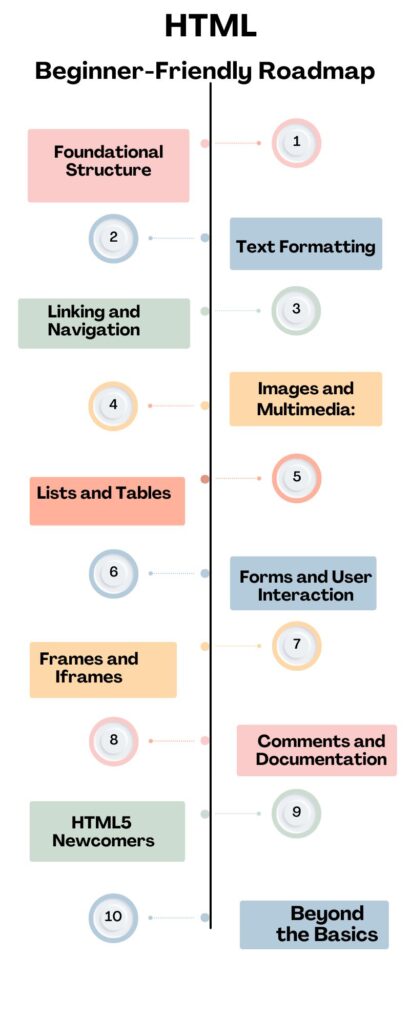HTML Roadmap for beginners : Conquering HTML can feel like a daunting task, but by breaking it down into manageable categories, you’ll be well on your way to building websites in no time. Here’s a breakdown of 10 essential HTML areas to focus on:

1. Foundational Structure:
- The Big Three: Understand the roles of
<html>,<head>, and<body>tags, the core elements of every webpage. - Document Structure: Learn about semantic elements like
<header>,<nav>,<main>,<footer>that define sections for better organization and accessibility.
2. Text Formatting:
- Headings and Paragraphs: Master the use of
<h1>to<h6>for headings and<p>for paragraphs to structure your content. - Inline Elements: Explore tags like
<b>,<i>, and<strong>for bold, italic, and strong emphasis, as well as<br>for line breaks.
3. Linking and Navigation:
- The Mighty
<a>Tag: Learn how to create hyperlinks with the<a>tag to link to other pages or websites. - Navigation Structures: Understand how to use
<nav>and create navigation menus with unordered lists (<ul>) or ordered lists (<ol>).
4. Images and Multimedia:
- Embedding Images: Master the
<img>tag to include images in your webpages, specifying source and alternative text for accessibility. - Beyond Images: Explore other multimedia options like embedding videos using the
<iframe>tag.
5. Lists and Tables:
- Ordered vs. Unordered: Learn the difference between unordered lists (
<ul>) for items in any order and ordered lists (<ol>) for sequential steps. - Tabular Data: Understand how to create tables with
<table>,<tr>(table row), and<td>(table data) tags to organize complex information.
6. Forms and User Interaction:
- Collecting Information: Explore form elements like
<input>(text boxes),<textarea>(larger text areas), and<select>(dropdown menus) for user input. - Submitting Data: Learn how to use the
<form>tag to capture user input and submit it to a server for processing.
7. Frames and Iframes:
- Dividing the Page (Optional): Understand how
<frame>and<iframe>tags can be used to divide your page into sections or embed external content, but use them cautiously due to accessibility concerns.
8. Comments and Documentation:
- Adding Notes: Explore using “ comments to add notes within your code for clarification, invisible to users but helpful for developers.
9. HTML5 Newcomers:
- Modern Features: Explore new HTML5 elements like
<header>,<nav>,<section>, and<article>that provide even more semantic structure. - Media Support: Learn about HTML5’s built-in audio and video elements for embedding multimedia without additional plugins.
10. Beyond the Basics:
- Validation and Best Practices: Once you grasp the fundamentals, ensure your code is valid and well-structured using online HTML validators and following best practices.
- Practice Makes Perfect: Solidify your learning by building small projects like a personal portfolio or a simple website to apply your knowledge in action.
